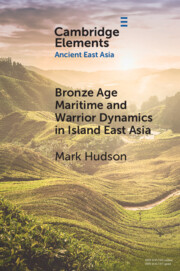74 results
Chapter 8 - Cognitive Behavioral Principles for Conceptualizing Young People’s Eco-Emotions and Eco-Distress
- from Part I - Conceptual Foundations of Climate Distress in Young People
-
-
- Book:
- Climate Change and Youth Mental Health
- Print publication:
- 13 June 2024, pp 148-167
-
- Chapter
- Export citation
Bone-artefact production in late Neolithic central China: evidence from Pingliangtai
-
- Article
-
- You have access
- Open access
- HTML
- Export citation
The origins of saddles and riding technology in East Asia: discoveries from the Mongolian Altai
-
- Article
-
- You have access
- Open access
- HTML
- Export citation
The role of lithology and climate on bedrock river incision and terrace development along the Buffalo National River, Arkansas
-
- Journal:
- Quaternary Research / Volume 115 / September 2023
- Published online by Cambridge University Press:
- 26 May 2023, pp. 179-193
-
- Article
- Export citation

Bronze Age Maritime and Warrior Dynamics in Island East Asia
-
- Published online:
- 25 March 2022
- Print publication:
- 07 July 2022
-
- Element
-
- You have access
- Open access
- HTML
- Export citation
Demography, trade and state power: a tripartite model of medieval farming/language dispersals in the Ryukyu Islands
-
- Journal:
- Evolutionary Human Sciences / Volume 4 / 2022
- Published online by Cambridge University Press:
- 26 January 2022, e4
-
- Article
-
- You have access
- Open access
- HTML
- Export citation
Sustaining University Operations During the COVID-19 Pandemic
-
- Journal:
- Disaster Medicine and Public Health Preparedness / Volume 16 / Issue 5 / October 2022
- Published online by Cambridge University Press:
- 08 March 2021, pp. 1901-1909
-
- Article
- Export citation
“Flipped Learning” in Disaster Triage: Polarizing Medical Student Attainment?
-
- Journal:
- Disaster Medicine and Public Health Preparedness / Volume 16 / Issue 2 / April 2022
- Published online by Cambridge University Press:
- 04 November 2020, pp. 421-422
-
- Article
-
- You have access
- HTML
- Export citation
Archaeolinguistic evidence for the farming/language dispersal of Koreanic
-
- Journal:
- Evolutionary Human Sciences / Volume 2 / 2020
- Published online by Cambridge University Press:
- 14 October 2020, e52
-
- Article
-
- You have access
- Open access
- HTML
- Export citation
Maps
-
- Book:
- The Cambridge World History of Violence
- Published online:
- 13 March 2020
- Print publication:
- 26 March 2020, pp xiv-xiv
-
- Chapter
- Export citation
Part II - Prehistoric and Ancient Warfare
-
- Book:
- The Cambridge World History of Violence
- Published online:
- 13 March 2020
- Print publication:
- 26 March 2020, pp 179-296
-
- Chapter
- Export citation
Part III - Intimate and Collective Violence
-
- Book:
- The Cambridge World History of Violence
- Published online:
- 13 March 2020
- Print publication:
- 26 March 2020, pp 297-438
-
- Chapter
- Export citation
Introduction to Volume I
-
-
- Book:
- The Cambridge World History of Violence
- Published online:
- 13 March 2020
- Print publication:
- 26 March 2020, pp 19-36
-
- Chapter
- Export citation
Part IV - Religion, Ritual and Violence
-
- Book:
- The Cambridge World History of Violence
- Published online:
- 13 March 2020
- Print publication:
- 26 March 2020, pp 439-530
-
- Chapter
- Export citation
Part VI - Representations and Constructions of Violence
-
- Book:
- The Cambridge World History of Violence
- Published online:
- 13 March 2020
- Print publication:
- 26 March 2020, pp 587-703
-
- Chapter
- Export citation
Copyright page
-
- Book:
- The Cambridge World History of Violence
- Published online:
- 13 March 2020
- Print publication:
- 26 March 2020, pp vi-vi
-
- Chapter
- Export citation
Part I - The Origins of Conflict
-
- Book:
- The Cambridge World History of Violence
- Published online:
- 13 March 2020
- Print publication:
- 26 March 2020, pp 37-178
-
- Chapter
- Export citation
7 - The Origins of Violence and Warfare in the Japanese Islands
- from Part I - The Origins of Conflict
-
-
- Book:
- The Cambridge World History of Violence
- Published online:
- 13 March 2020
- Print publication:
- 26 March 2020, pp 160-178
-
- Chapter
- Export citation
Figures
-
- Book:
- The Cambridge World History of Violence
- Published online:
- 13 March 2020
- Print publication:
- 26 March 2020, pp xi-xiii
-
- Chapter
- Export citation
Contents
-
- Book:
- The Cambridge World History of Violence
- Published online:
- 13 March 2020
- Print publication:
- 26 March 2020, pp vii-x
-
- Chapter
- Export citation



